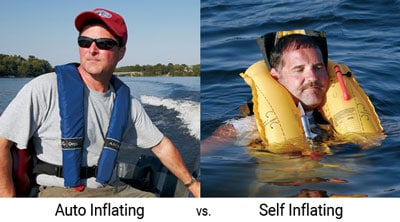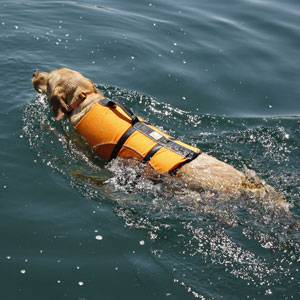 Any boater or water enthusiast knows the importance of a good personal floatation device, or PFD. A PFD can, quite literally, be the difference between life and death on the water, so purchasing one should not be take lightly.
Any boater or water enthusiast knows the importance of a good personal floatation device, or PFD. A PFD can, quite literally, be the difference between life and death on the water, so purchasing one should not be take lightly.
There are several different types of life vests on the market, but a relatively new option that’s quickly becoming quite popular is the inflatable PFD. Here is everything you should know if you are considering purchasing an inflatable life vest.
Why Should I Choose an Inflatable Life Vest?
Inflatable life vests and traditional life vests serve the same basic function, keeping you afloat in the water. Inflatable life vests are significantly less cumbersome than their traditional counterparts, making them easier to store when not in use.
Because of their slim nature, the inflatable life vest is more comfortable to wear and a great choice for sailing or stand up paddleboarding.
In fact, studies have shown that boaters are more likely to wear the inflatable life vest for the duration of their time on the water, whereas the traditional life vests are generally stored in the boat, most times, unworn.
Inflatable life vests are not suitable for certain water activities such as personal water crafts, such as jet skis since you will most likely be IN the water and you don’t want the vest to automatically inflate. Instead, go with a good life jacket intended for watersports.
Because inflatable life vests take time to inflate once submerged in water, they are also not suitable for children under the age of 16 or for non-swimmers. However, these inflatable life vests are believed to be more efficient of turning and hold the victim face up and above the water once inflated than traditional life vests.
Because of their sleek design, inflatable life vests offer little to no protection against hypothermia. The traditional neoprene vests are bulkier and offer slightly more protection against cold waters.
Inflatables must be more regularly inspected than traditional vests. The CO2 cartridges must be in working order and regular tests to the bladder must be performed to make sure there is no leak. An inflatable life vest that doesn’t inflate won’t be of much assistance in the event of an emergency.
Most Inflatable Life Vests are Coast Guard Approved, but Some are Not
It is extremely important to know if any vest you are considering purchasing is coast guard approved for your desired activity. For example, if you are going to spend most of your time boating in open waters, you need to be looking at a Type I, II, or V PFD.
However, if your time on the water will be spent more typically on a lake or inland waters, a Type III would be fine. Inflatable life vests are typically rated as a specialty PFD (Type V), so be sure to know your product and its purpose prior to purchasing.
Which type of Inflatable Life Vest is the Right Choice for Me?
There are two basic types of inflatable life vests, the self inflating life vest, also known as the auto inflatable life jacket, or the manually inflating life vest. Both of these types of vests contain a backup oral inflation tube in the event that the main inflation should fail.
The self inflating life vest, as it’s name suggests, auto inflates when it is submerged in water or a cord is pulled. The CO2 cartridge is activated when a pin, sometimes referred to as the pill, is dissolved by the water and the vest inflates.
This lag time of the dissolution of the pin and the activation of the vest is the main reason this type of jacket is not recommended for non swimmers or children.
The force of which it inflates, however, is more than sufficient to push you to the surface of the water. Because of its ability to self inflate, the auto inflatable life jacket is ideal for boating on rough waters.
If you were to lose consciousness before going into the water, having the auto inflatable life vest would save your life.
The manual inflating life vest is similar in most ways to the self inflating life vest, except for the way it is activated. Whereas the auto inflating vest activates when submerged in water, a rip cord must be pulled on the manually inflating vest to activate the CO2 cartridge to cause the jacket to inflate.
In most situations, the manual inflating life jacket would be sufficient for your needs.
The only down fall of this particular life vest would be your inability to pull the rip cord in an emergency situation due to lost of consciousness, limited hand or arm mobility, or just sheer panic. These particular instances are rare, but are definitely worth consideration when deciding on the right vest for you.

With all of the different life vests available, there is certainly one that is perfectly suited for you and your needs. The type of boating you will be doing, your comfort level on the water, and your ability to swim, are all factors to consider when making your life vest purchase.
Whatever life vest you decide is right for you, just be sure to wear it. Life vests only save lives when worn.
Sources:
- https://www.uscg.mil/hq/cg5/cg5214/pfdselection.asp
- http://www.pfdma.org/choosing/inflatable.aspx
- http://www.go2marine.com/go2_structure/mfr/stearns/inflatable/inflatables.shtml


